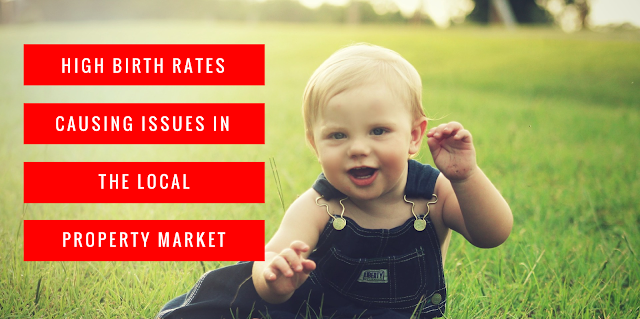
As more babies are being born to Rutland mothers, I believe this increase will continue to add pressure to the over stretched Rutland property market and materially affect the local property market in the years to come.
On the back of 8 years of ever incremental increasing birth rates, a significant 2.83 babies were born for every new home that was built in the Rutland County Council area in 2016. Further exacerbating the Rutland housing shortage, meaning demand for housing (be it to buy or rent), has remained high.
The high birth rate has meant Rutland rents and Rutland property prices have remained resilient, and even with the challenges the economy has felt over the last 8 years, they will continue to remain high in the years to come.
This ratio of births to new homes has reach one its highest levels since 1945 (back in the early 1970’s the average was only 1.5 births for every household built). Looking at the local birth rates, the latest figures show that here the Rutland council area, there was an average of 59.7 births per 1,000 women aged 15-44.
Interestingly, the national average is 61.7 births per 1,000 women aged 15–44, and for the East Midlands region the figure is 61.3 births per 1,000 women aged 15-44.
The number of births from Rutland women between the ages of 20-29 are higher than the national average, but those aged between 35-44 were closer to the national average. Overall the birth rate is increasing, and when that fact is combined with the ever-increasing life expectancy in Rutland, the high levels of net migration into the area over the last 14 years (which I talked about in previous articles) and the higher predominance of single person households, this can only mean one thing - a huge surge in the need for housing in Rutland.

MP’s, planners, central government and local communities need to recognise that with individuals living longer, a growing population and, whilst divorce rates may have dropped recently they are still at a relatively high level (meaning one household becomes two) ... demand for property is simply outstripping supply.
This ratio of births to new homes has reach one its highest levels since 1945 (back in the early 1970’s the average was only 1.5 births for every household built). Looking at the local birth rates, the latest figures show that here the Rutland council area, there was an average of 59.7 births per 1,000 women aged 15-44.
Interestingly, the national average is 61.7 births per 1,000 women aged 15–44, and for the East Midlands region the figure is 61.3 births per 1,000 women aged 15-44.
The number of births from Rutland women between the ages of 20-29 are higher than the national average, but those aged between 35-44 were closer to the national average. Overall the birth rate is increasing, and when that fact is combined with the ever-increasing life expectancy in Rutland, the high levels of net migration into the area over the last 14 years (which I talked about in previous articles) and the higher predominance of single person households, this can only mean one thing - a huge surge in the need for housing in Rutland.

MP’s, planners, central government and local communities need to recognise that with individuals living longer, a growing population and, whilst divorce rates may have dropped recently they are still at a relatively high level (meaning one household becomes two) ... demand for property is simply outstripping supply.
The simple fact is that more Rutland properties need building - for buying and renting.
Only 1.1% of the country is being built on with new homes. Now, I am not suggesting we build tower blocks with views over Rutland Water, but the obsession of not building on any green belt land should be carefully re-considered.
Agreed, we need to build on brownfield sites first, but there aren’t hundreds of acres of brownfield sites in Rutland, and what brownfield sites there are, building on them can only work with complementary public investment. Many such sites are contaminated and aren’t financially viable to develop, so unless the government invests, they will never be built on.
I am not saying we should crudely go ‘hell for leather’ building on our green belt, but we need a new approach to enable some parts of the countryside to be regarded more positively by local authorities, politicians and communities and allow considered and empathetic development.
Society in the UK needs to look at the green belts outside of their leisure and visual appeal, and assess how they can help to shape the way we live in the most even-handed way.
With prices and demand remaining strong in both the sales and lettings market, if you would like to arrange for a valuation of your property, please click here:
We are here to help you buy, sell, rent and manage your homes and investments.
David Crooke
Owner & Managing Director
01572 725 825

No comments:
Post a Comment